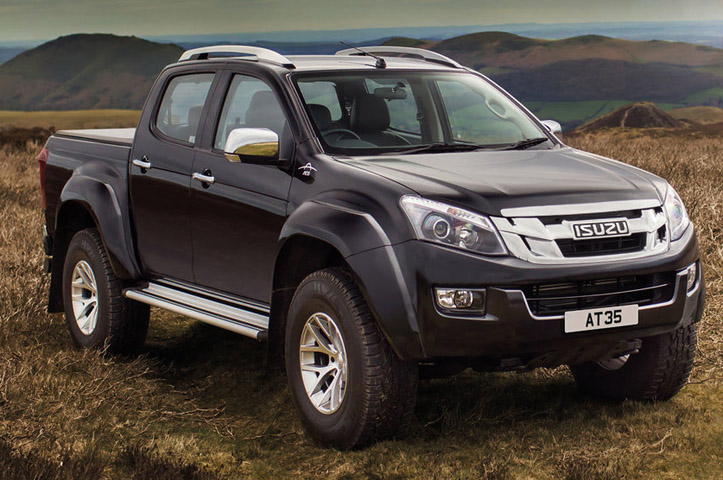
Isuzu doesn’t have quite a bit of name in the UK, and the D-Max is the main vehicle the Japanese brand offers here anymore. Still, when it first went on sale in 2012 it got to be one of the best choices.
However the volume automakers have been extremely busy in 2015 and 2016, propelling new trucks with some huge overhauls. The Nissan Navara, Mitsubishi’s L200, Ford Ranger and the Toyota Hilux are all yelling for clients’ consideration on forecourts in the UK, with the Fiat Fullback, Renault Alaskan and an up and coming Mercedes-Benz pick-up on the way.
This means the D-Max is starting to fall behind, with newer models offering vastly improved interiors and a more civilised driving experience. This might be a deal breaker for some, but Isuzu says its customers are more interested in a no-nonsense pick-up that’s fit for purpose.
The D-Max is available in single, extended and double cab body styles, with five main specifications to choose from: the basic utility model, Eiger, Yukon, Utah and Blade. There’s also a special edition Fury model aimed at younger buyers, which gets a few sporty-looking upgrades.
In 2016 Isuzu launched a D-Max with some seriously rugged upgrades. The Arctic Truck AT35 is on sale in selected Isuzu dealers, and features huge tyres and overhauled suspension that makes it extremely capable off-road whatever the temperature.
The extended cab model gets a side-access panel on both sides to make it easier to get at the extra space inside the cab, while the double cab has the normal four-door layout with a rear bench seat.
Fueled by a 2.5-litre twin-turbo diesel, the D-Max is the best choice for towing – the 4×4 models can tow up to 3,500kg and can convey a 1,058 – 1,136kg payload. It’s accessible with either a six-speed manual or a five-speed automatic gearbox.
All models utilise the same 2.5-litre twin-turbo diesel engine, which creates 163bhp and 400Nm of torque. With the six-speed manual gearbox the Isuzu D-Max returns 38.7mpg, with CO2 emissions of 194g/km. This drops to 33.6mpg and 220g/km with the optional five-speed programmed transmission.
The new Nissan Navara and Mitsubishi L200 are a superior bet if running expenses are a need, with those trucks returning 44.9mpg and 44.1mpg separately.
Isuzu offers a fantastic guarantee, be that as it may, at 5 years or 125,000 miles. That trumps both the Navara and L200, neither offering more than 100,000 miles of cover. Isuzu hasn’t released fuel figures for the D-Max Arctic Trucks AT35, but you can be sure that the larger diameter wheels and tyres alone will have a substantial impact.
Isuzu offers every possible blend with the D-Max, from single cab to extended and double cab models. It’s likewise accessible with 4×2 and 4×4 drivetrains, in addition to a low-extend gearbox that is helpful for going off-roading.
The load bay in the single cab model measures at 2,305mm by 1,570mm, with a payload capacity of 1,128kg or 1,136 depending on the drivetrain. Head up to an extended cab for dimensions of 1,795mm by 1,530mm and a payload capacity of 1,085kg.
The double cab gets a load bay of 1,552mm by 1,530mm, but the payload capacity varies based on the model you choose – with the maximum being 1,096kg. The towing weight for 4×4 models is 3,500kg, dropping to 2.500kg otherwise.
Isuzu also offers a wide range of load covers and hardtop backs for the D-Max range, for both extended-cab and double-cab models.
A dealer-fit tow bar receiver hitch with electrics is available, plus roof bars and frames and cargo rails to hold loads in place in the bed.
There’s even a bed extender available that fits in the rear of the load bed to allow longer loads to be carried. By offering a full range of cab options, Isuzu has covered every sector of the pick-up market, from single-cab workhorse to luxury dual-purpose double cab.
All D-Max models come with ABS brakes, electronic stability control (ESC) and traction control as standard, which is par for the course in the pick-up market.
There have been no reported problems with the 2.5-litre engine and Isuzu offers a five-year/125,000-mile warranty on all models, which give you some idea of how confident the brand is about the D-Max.
In fact an unmodified D-Max competing in the BCCC was the only competitor for two years running to never have a mechanical failure.
In the cab, even the basic Utility trim models have dual front, side and curtain airbags, and height-adjustable seatbelts for maximum occupant protection. Four-wheel-drive models have the benefit of 4×4 selection on the move for added security in slippery conditions.
The Isuzu D-Max only has one engine, a 163bhp 2.5-litre twin-turbo diesel, but with 400Nm of torque it’s a strong performer. It fills the cabin with rattly canal-boat noise when you accelerate, but once you’re up to speed it settles down to a quiet rumble.
If you want to go places all other pick ups aren’t capable of doing, you’ll want the D-Max AT35. Input from legendary Icelandic truck modifiers Arctic Trucks means it gets huge 35-inch off-road tyres with wider wheels, a 55mm ride height boost and special Fox Performance suspension. It’s been designed to transport people around some of the coldest and most isolated parts of the globe, so it’s more than able to tackle a bit of green laning in Britain.
The downside of that unstoppable off-road prowess is performance, with is reduced over the normal D-Max, and handling, which is softer and floatier thank to those bulbous tyres. Still, it’s surprisingly useable day-to-day, but will cost a fair bit more to buy and run than the regular D-Max.